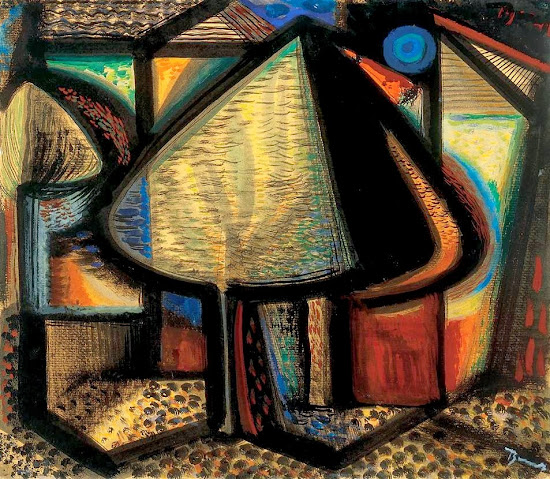Biography:
Bene Geza. Painter. He was educated in Ruttka and Igló. He was only ten years old when he received the first prize of the Munich international children's drawing exhibition. From 1921 to 1925 he studied at the National Art Academy in Budapest. His masters included János Vaszary and Viktor Olgyai. Having finished his studies he became a member of the New Society of Artists and was present at all of their exhibitions. Apart from the annual national exhibitions he was present at exhibitions in Krakow, Florence, Venice, Zurich, Stockholm and Vienna. In 1922 he was granted a scholarship to Rome. In 1923 he was awarded the Szinnyei Prize.
He became a member of the Association of New Artists (UME) in 1928 and of Rippl Rónai Society in 1948. In 1927 he was present at the Exhibition of Hungarian Impressionists.
From the second half of the 1930s a constructivist creative intention became more intensive in his works. By the 1940s his figural compositions had been replaced by predominantly constructivist landscape compositions. He was one of the outstanding masters of a constructivist movement called Szentendre Style Club.
After 1945 his creative power reached its pinnacle. Apart from his remarkably successful one-man exhibition he was present the Free National Exhibitions in the Capital City Picture Gallery and at the "100 Years of Hungarian Graphic Art" and the "One Hundred Hungarian Artists" exhibitions organised in the same location.
Bene Geza. Painter. He was educated in Ruttka and Igló. He was only ten years old when he received the first prize of the Munich international children's drawing exhibition. From 1921 to 1925 he studied at the National Art Academy in Budapest. His masters included János Vaszary and Viktor Olgyai. Having finished his studies he became a member of the New Society of Artists and was present at all of their exhibitions. Apart from the annual national exhibitions he was present at exhibitions in Krakow, Florence, Venice, Zurich, Stockholm and Vienna. In 1922 he was granted a scholarship to Rome. In 1923 he was awarded the Szinnyei Prize.
He became a member of the Association of New Artists (UME) in 1928 and of Rippl Rónai Society in 1948. In 1927 he was present at the Exhibition of Hungarian Impressionists.
From the second half of the 1930s a constructivist creative intention became more intensive in his works. By the 1940s his figural compositions had been replaced by predominantly constructivist landscape compositions. He was one of the outstanding masters of a constructivist movement called Szentendre Style Club.
After 1945 his creative power reached its pinnacle. Apart from his remarkably successful one-man exhibition he was present the Free National Exhibitions in the Capital City Picture Gallery and at the "100 Years of Hungarian Graphic Art" and the "One Hundred Hungarian Artists" exhibitions organised in the same location.









No hay comentarios.:
Publicar un comentario